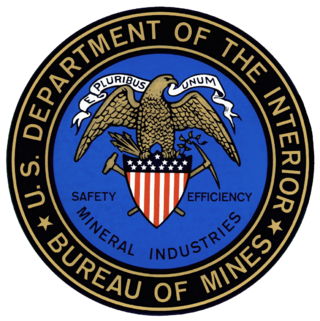
The United States Department of Labor (DOL) is one of the executive departments of the U.S. federal government. It is responsible for the administration of federal laws governing occupational safety and health, wage and hour standards, unemployment benefits, reemployment services, and occasionally, economic statistics. It is headed by the secretary of labor, who reports directly to the president of the United States and is a member of the president's Cabinet.

The Occupational Safety and Health Act of 1970 is a US labor law governing the federal law of occupational health and safety in the private sector and federal government in the United States. It was enacted by Congress in 1970 and was signed by President Richard Nixon on December 29, 1970. Its main goal is to ensure that employers provide employees with an environment free from recognized hazards, such as exposure to toxic chemicals, excessive noise levels, mechanical dangers, heat or cold stress, or unsanitary conditions. The Act created the Occupational Safety and Health Administration (OSHA) and the National Institute for Occupational Safety and Health (NIOSH).

Mining in the engineering discipline is the extraction of minerals from the ground. Mining engineering is associated with many other disciplines, such as mineral processing, exploration, excavation, geology, metallurgy, geotechnical engineering and surveying. A mining engineer may manage any phase of mining operations, from exploration and discovery of the mineral resources, through feasibility study, mine design, development of plans, production and operations to mine closure.

For most of the 20th century, the United States Bureau of Mines (USBM) was the primary United States government agency conducting scientific research and disseminating information on the extraction, processing, use, and conservation of mineral resources. The Bureau was abolished in 1996.

The Mine Safety and Health Administration (MSHA) is a large agency of the United States Department of Labor which administers the provisions of the Federal Mine Safety and Health Act of 1977 to enforce compliance with mandatory safety and health standards as a means to eliminate fatal accidents, to reduce the frequency and severity of nonfatal accidents, to minimize health hazards, and to promote improved safety and health conditions in the nation's mines. MSHA carries out the mandates of the Mine Act at all mining and mineral processing operations in the United States, regardless of size, number of employees, commodity mined, or method of extraction. David Zatezalo was sworn in as Assistant Secretary of Labor for Mine Safety and Health, and head of MSHA, on November 30, 2017. He served until January 20, 2021. Jeannette Galanais served as Acting Assistant Secretary by President Joe Biden on February 1, 2021 until Christopher Williamson took office on April 11, 2022.

The Federal Mine Safety and Health Review Commission is an independent adjudicative agency of the United States government that provides administrative trial and appellate review of legal disputes arising under the Federal Mine Safety and Health Amendments Act, or Mine Act, of 1977.

Massey Energy Company was a coal extractor in the United States with substantial operations in West Virginia, Kentucky and Virginia. By revenue, it was the fourth largest producer of coal in the United States and the largest coal producer in Central Appalachia. By coal production weight, it was the sixth largest producer of coal in the United States.

The Federal Coal Mine Health and Safety Act of 1969, U.S. Public Law 91-173, generally referred to as the Coal Act, was passed by the 91st United States Congressional session and enacted into law by the 37th President of the United States Richard Nixon on December 30, 1969.

The Sago Mine disaster was a coal mine explosion on January 2, 2006, at the Sago Mine in Sago, West Virginia, United States, near the Upshur County seat of Buckhannon. The blast and collapse trapped 13 miners for nearly two days; only one survived. It was the worst mining disaster in the United States since the Jim Walter Resources Mine disaster in Alabama on September 23, 2001, and the worst disaster in West Virginia since the 1968 Farmington Mine disaster. It was exceeded four years later by the Upper Big Branch Mine disaster, also a coal mine explosion in West Virginia, which killed 29 miners in April 2010.

TheFederal Mine Safety and Health Act of 1977 amended the Coal Mine Safety and Health Act of 1969. It can be found in the United States Code under Title 30, Mineral Lands and Mining, Chapter 22, Mine Safety and Health.
The Safety and Health in Mines Convention, 1995 was an International Labour Organization Convention adopted at the 82nd International Labour Conference (ILC) of the International Labour Organization (ILO). During the adoption of the Safety and Health in Mines Convention (C176), it was recognized that there are inherent hazards in the mining workplace, and there was a need for a convention to address them.

The United States National Mine Health and Safety Academy is a federal academy responsible for training the mine safety and health inspectors and technical support personnel of the Mine Safety and Health Administration.

An abandoned mine refers to a former mining or quarrying operation that is no longer in use and has no responsible entity to finance the cost of remediation and/or restoration of the mine feature or site. Such mines are typically left unattended and may pose safety hazards or cause environmental damage without proper maintenance. The term incorporates all types of old mines, including underground shaft mines and drift mines, and surface mines, including quarries and placer mining. Typically, the cost of addressing the mine's hazards is borne by the public/taxpayers/the government.

The National Mine Map Repository (NMMR) is part of the United States Department of the Interior (DOI), Office of Surface Mining Reclamation and Enforcement. The NMMR resides in the Pittsburgh suburb of Green Tree, Pennsylvania, and collects and maintains mine map information and images for the entire country, including data and maps of coal mines in the anthracite coal region of northeastern Pennsylvania. The Green Tree facility provides and stores, digitally and in microfilm, over 182,000 maps of abandoned mines. This repository contains maps of mine workings from the 1790s to the present day. It serves as a point of reference for mine maps and other information for both surface and underground mines throughout the United States. It also serves as a location to retrieve mine maps in an emergency. The NMMR provides services ranging from retrieving mine related data for economic analysis to assessing the potential risk associated with underground mining. Through analysis of mine maps and related information, the repository assists private and public sectors in industrial and commercial development, highway construction, and the preservation of public health, safety, and welfare. In addition, they collect, reproduce, and maintain a national inventory of mine maps and supporting documentation for private and public interests.

Joe Main is an American government official who formerly served as the Assistant Secretary of Labor for Mine Safety and Health and head of the United States Department of Labor's Mine Safety and Health Administration. He was nominated to serve the position by Barack Obama and took office after being confirmed by the United States Senate on October 21, 2009.

The Upper Big Branch Mine disaster occurred on April 5, 2010 roughly 1,000 feet (300 m) underground in Raleigh County, West Virginia at Massey Energy's Upper Big Branch coal mine located in Montcoal. Twenty-nine out of thirty-one miners at the site were killed. The coal dust explosion occurred at 3:27 pm. The accident was the worst in the United States since 1970, when 38 miners were killed at Finley Coal Company's No. 15 and 16 mines in Hyden, Kentucky. A state funded independent investigation later found Massey Energy directly responsible for the blast.

The Federal Coal Mine Safety Act of 1952 is a U.S. law authorizing the federal government to conduct annual inspections of underground coal mines with more than 15 workers, and gave the United States Bureau of Mines the authority to shut down a mine in cases of "imminent danger." The Act authorized the assessment of civil penalties against mine operators for failing to comply with an order to shut down or for refusing to give inspectors access to mine property. The law did not authorize monetary penalties for noncompliance with the safety provisions. In 1966, Congress extended coverage to all underground coal mines.

David George Zatezalo is an American coal industry executive who served as the Assistant Secretary of Labor for Mine Safety and Health in President Donald Trump's administration, where he headed the Mine Safety and Health Administration.
J. Davitt McAteer is an American lawyer, author, and activist from Fairmont, West Virginia. McAteer was appointed to the position of assistant secretary for the Mine Safety and Health Administration from 1993 to 2000 under President Bill Clinton. Throughout his career, McAteer has been an advocate for safe working conditions for miners, particularly in the coal industry. After the Upper Big Branch Mine disaster of 2010, where an explosion caused by negligence led to the death of 29 miners, McAteer Served on Governor Earl Ray Tomblin's independent investigation panel to determine the cause of the explosion. McAteer is the author of "Monongah: The Tragic Story of the 1907 Monongah Mine Disaster".

The Scotia Mine was a coal mine that operated in the community of Oven Fork in Letcher County, Kentucky. The mine began operations in 1962, as a subsidiary of the Blue Diamond Coal Company. In March 1976, two explosions occurred within the mine, killing 26 miners. The explosions led to the passage of several acts relating to safety in coal mines.















